Broadband Amplification in the 2.6–2.9 μm Wavelength Range in High-Purity Er3+-Doped Zinc-Tellurite Fibers Pumped by Diode Lasers
Abstract
:1. Introduction
2. Materials and Methods
2.1. Zinc Tellurite Erbium-Doped Fiber
2.1.1. Glasses and Preform Preparation
2.1.2. DSC-Measurements
2.1.3. Transmission Spectra
2.1.4. Optical Fiber Production and Its Optical Loss
2.2. Experimental Setup
3. Results
3.1. Luminescent Properties of Erbium-Doped TZL Fiber
3.2. On-off Gain Performance of Erbium-Doped TZL Fiber
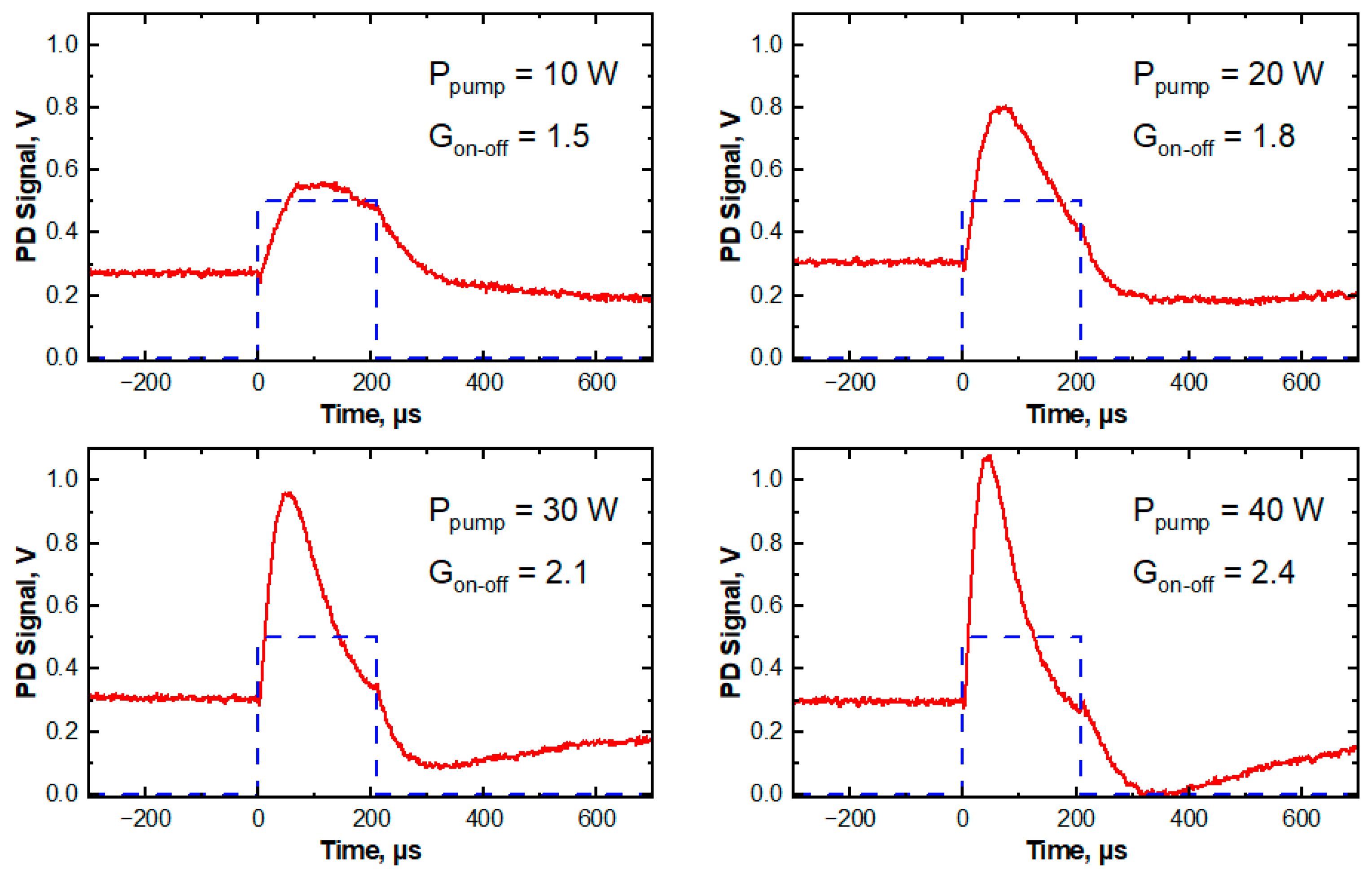
4. Discussion
5. Conclusions
Author Contributions
Funding
Institutional Review Board Statement
Informed Consent Statement
Data Availability Statement
Conflicts of Interest
References
- Ebrahim-Zadeh, M.; Sorokina, I.T. (Eds.) Mid-Infrared Coherent Sources and Applications; NATO Science for Peace and Security Series B: Physics and Biophysics; Springer: Dordrecht, The Netherlands, 2008; ISBN 978-1-4020-6439-5. [Google Scholar]
- Jackson, S.D. Towards High-Power Mid-Infrared Emission from a Fibre Laser. Nat. Photonics 2012, 6, 423–431. [Google Scholar] [CrossRef]
- Petersen, C.R.; Møller, U.; Kubat, I.; Zhou, B.; Dupont, S.; Ramsay, J.; Benson, T.; Sujecki, S.; Abdel-Moneim, N.; Tang, Z.; et al. Mid-Infrared Supercontinuum Covering the 1.4–13.3 µm Molecular Fingerprint Region Using Ultra-High NA Chalcogenide Step-Index Fibre. Nat. Photonics 2014, 8, 830–834. [Google Scholar] [CrossRef]
- Robichaud, L.-R.; Fortin, V.; Gauthier, J.-C.; Châtigny, S.; Couillard, J.-F.; Delarosbil, J.-L.; Vallée, R.; Bernier, M. Compact 3–8 µm Supercontinuum Generation in a Low-Loss As2Se3 Step-Index Fiber. Opt. Lett. 2016, 41, 4605. [Google Scholar] [CrossRef] [PubMed]
- Kedenburg, S.; Strutynski, C.; Kibler, B.; Froidevaux, P.; Désévédavy, F.; Gadret, G.; Jules, J.-C.; Steinle, T.; Mörz, F.; Steinmann, A.; et al. High Repetition Rate Mid-Infrared Supercontinuum Generation from 13 to 53 µm in Robust Step-Index Tellurite Fibers. J. Opt. Soc. Am. B 2017, 34, 601. [Google Scholar] [CrossRef]
- Yin, K.; Zhang, B.; Yao, J.; Yang, L.; Liu, G.; Hou, J. 19–36 µm Supercontinuum Generation in a Very Short Highly Nonlinear Germania Fiber with a High Mid-Infrared Power Ratio. Opt. Lett. 2016, 41, 5067. [Google Scholar] [CrossRef]
- Yang, L.; Zhang, B.; Jin, D.; Wu, T.; He, X.; Zhao, Y.; Hou, J. All-Fiberized, Multi-Watt 2–5-µm Supercontinuum Laser Source Based on Fluoroindate Fiber with Record Conversion Efficiency. Opt. Lett. 2018, 43, 5206. [Google Scholar] [CrossRef]
- Yang, L.; Zhang, B.; He, X.; Deng, K.; Liu, S.; Hou, J. High-Power Mid-Infrared Supercontinuum Generation in a Fluoroindate Fiber with over 2 W Power beyond 3.8 µm. Opt. Express 2020, 28, 14973. [Google Scholar] [CrossRef] [PubMed]
- Aydın, Y.O.; Fortin, V.; Maes, F.; Jobin, F.; Jackson, S.D.; Vallée, R.; Bernier, M. Diode-Pumped Mid-Infrared Fiber Laser with 50% Slope Efficiency. Optica 2017, 4, 235. [Google Scholar] [CrossRef]
- Aydin, Y.O.; Fortin, V.; Vallée, R.; Bernier, M. Towards Power Scaling of 28 µm Fiber Lasers. Opt. Lett. 2018, 43, 4542. [Google Scholar] [CrossRef]
- Shen, Y.; Wang, Y.; Zhu, F.; Ma, L.; Zhao, L.; Chen, Z.; Wang, H.; Huang, C.; Huang, K.; Feng, G. 200 ΜJ, 13 Ns Er:ZBLAN Mid-Infrared Fiber Laser Actively Q-Switched by an Electro-Optic Modulator. Opt. Lett. 2021, 46, 1141. [Google Scholar] [CrossRef]
- Luo, H.; Yang, J.; Li, J.; Liu, Y. Tunable Sub-300 Fs Soliton and Switchable Dual-Wavelength Pulse Generation from a Mode-Locked Fiber Oscillator around 2.8 Μm. Opt. Lett. 2021, 46, 841. [Google Scholar] [CrossRef] [PubMed]
- Jackson, S.D.; Jain, R.K. Fiber-Based Sources of Coherent MIR Radiation: Key Advances and Future Prospects (Invited). Opt. Express 2020, 28, 30964. [Google Scholar] [CrossRef] [PubMed]
- Guo, Y.; Li, M.; Hu, L.; Zhang, J. Intense 27 µm Emission and Structural Origin in Er3+-Doped Bismuthate (Bi2O3-GeO2-Ga2O3-Na2O) Glass. Opt. Lett. 2012, 37, 268. [Google Scholar] [CrossRef] [PubMed]
- Ma, Y.; Guo, Y.; Huang, F.; Hu, L.; Zhang, J. Spectroscopic Properties in Er3+ Doped Zinc- and Tungsten-Modified Tellurite Glasses for 2.7 µm Laser Materials. J. Lumin. 2014, 147, 372–377. [Google Scholar] [CrossRef]
- Chen, F.; Wei, T.; Jing, X.; Tian, Y.; Zhang, J.; Xu, S. Investigation of Mid-Infrared Emission Characteristics and Energy Transfer Dynamics in Er3+ Doped Oxyfluoride Tellurite Glass. Sci. Rep. 2015, 5, 10676. [Google Scholar] [CrossRef]
- Yu, J.; Zhang, M.; Lu, X.; Du, Y.; Brambilla, G.; Jia, S.; Wang, S.; Wang, P. Broadband 2.7 µm Mid-Infrared Emissions in Er3+-Doped PbO-PbF2-Bi2O3-Ga2O3 Glasses. Opt. Lett. 2020, 45, 4638. [Google Scholar] [CrossRef]
- Zhang, Y.; Xia, L.; Li, C.; Ding, J.; Li, J.; Zhou, Y. Dy3+/Er3+/Tm3+ Tri-Doped Tellurite Glass with Enhanced Broadband Mid-Infrared Emission. Opt. Laser Technol. 2022, 149, 107904. [Google Scholar] [CrossRef]
- Rivera, V.A.G.; Manzani, D. (Eds.) Technological Advances in Tellurite Glasses: Properties, Processing, and Applications; Springer Series in Materials Science; Springer International Publishing: Cham, Switzerland, 2017; Volume 254, ISBN 978-3-319-53036-9. [Google Scholar]
- Ohishi, Y.; Mori, A.; Yamada, M.; Ono, H.; Nishida, Y.; Oikawa, K. Gain Characteristics of Tellurite-Based Erbium-Doped Fiber Amplifiers for 15-µm Broadband Amplification. Opt. Lett. 1998, 23, 274. [Google Scholar] [CrossRef]
- Libatique, N.J.C.; Tafoya, J.; Viswanathan, N.K.; Jain, R.K.; Cable, A. ‘Field-Usable’ Diode-Pumped ~120 Nm Wavelength-Tunable CW Mid-IR Fibre Laser. Electron. Lett. 2000, 36, 791. [Google Scholar] [CrossRef]
- Dong, J.; Wei, Y.Q.; Wonfor, A.; Penty, R.V.; White, I.H.; Lousteau, J.; Jose, G.; Jha, A. Dual-Pumped Tellurite Fiber Amplifier and Tunable Laser Using Er3+Ce3+ Codoping Scheme. IEEE Photonics Technol. Lett. 2011, 23, 736–738. [Google Scholar] [CrossRef]
- Fu, S.; Zhu, X.; Wang, J.; Wu, J.; Tong, M.; Zong, J.; Li, M.; Wiersma, K.; Chavez-Pirson, A.; Peyghambarian, N. L-Band Wavelength-Tunable Er3+-Doped Tellurite Fiber Lasers. J. Lightwave Technol. 2020, 38, 1435–1438. [Google Scholar] [CrossRef]
- Muraviev, S.V.; Dorofeev, V.V.; Motorin, S.E.; Koltashev, V.V.; Koptev, M.Y.; Kim, A.V. Lasing at 2.72 µm in an Er3+-Doped High-Purity Tungsten–Tellurite Glass Fiber Laser. Opt. Lett. 2022, 47, 5821. [Google Scholar] [CrossRef] [PubMed]
- Muraviev, S.V.; Dorofeev, V.V.; Motorin, S.E.; Koptev, M.Y.; Kim, A.V. Broadband Gain Performance in the Mid-IR Using Supercontinuum: 2.7 µm Gain in High-Purity Er3+ Doped Tungsten Tellurite Glass Fibers. Appl. Opt. 2022, 61, 9701. [Google Scholar] [CrossRef] [PubMed]
- Gomes, L.; Oermann, M.; Ebendorff-Heidepriem, H.; Ottaway, D.; Monro, T.; Felipe Henriques Librantz, A.; Jackson, S.D. Energy Level Decay and Excited State Absorption Processes in Erbium-Doped Tellurite Glass. J. Appl. Phys. 2011, 110, 083111. [Google Scholar] [CrossRef]
- Kut’in, A.M.; Plekhovich, A.D.; Balueva, K.V.; Motorin, S.E.; Dorofeev, V.V. Thermal Properties of High Purity Zinc-Tellurite Glasses for Fiber-Optics. Thermochim. Acta 2019, 673, 192–197. [Google Scholar] [CrossRef]
- Anashkina, E.A.; Andrianov, A.V.; Dorofeev, V.V.; Kim, A.V.; Koltashev, V.V.; Leuchs, G.; Motorin, S.E.; Muravyev, S.V.; Plekhovich, A.D. Development of Infrared Fiber Lasers at 1555 Nm and at 2800 Nm Based on Er-Doped Zinc-Tellurite Glass Fiber. J. Non-Cryst. Solids 2019, 525, 119667. [Google Scholar] [CrossRef]
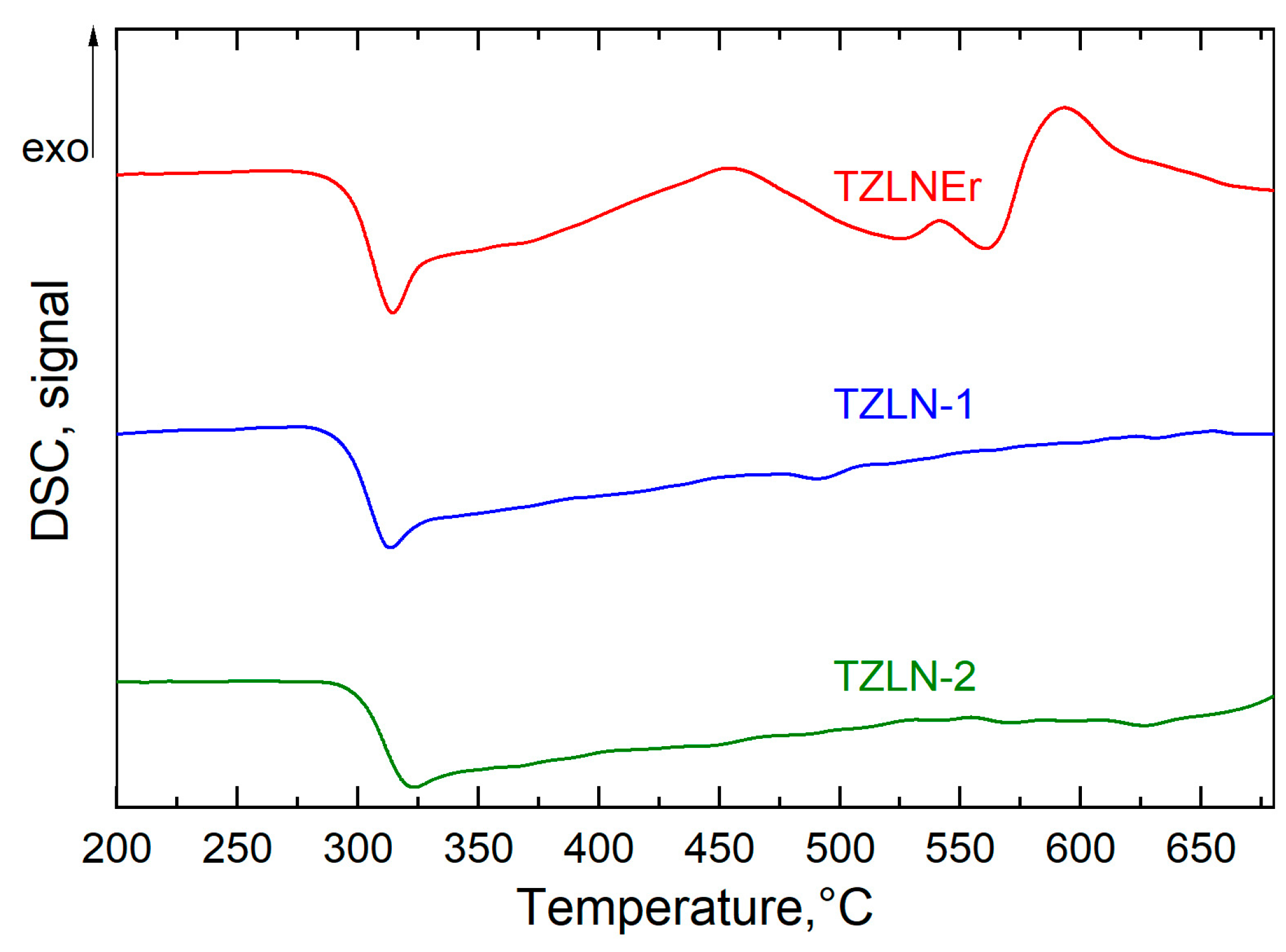

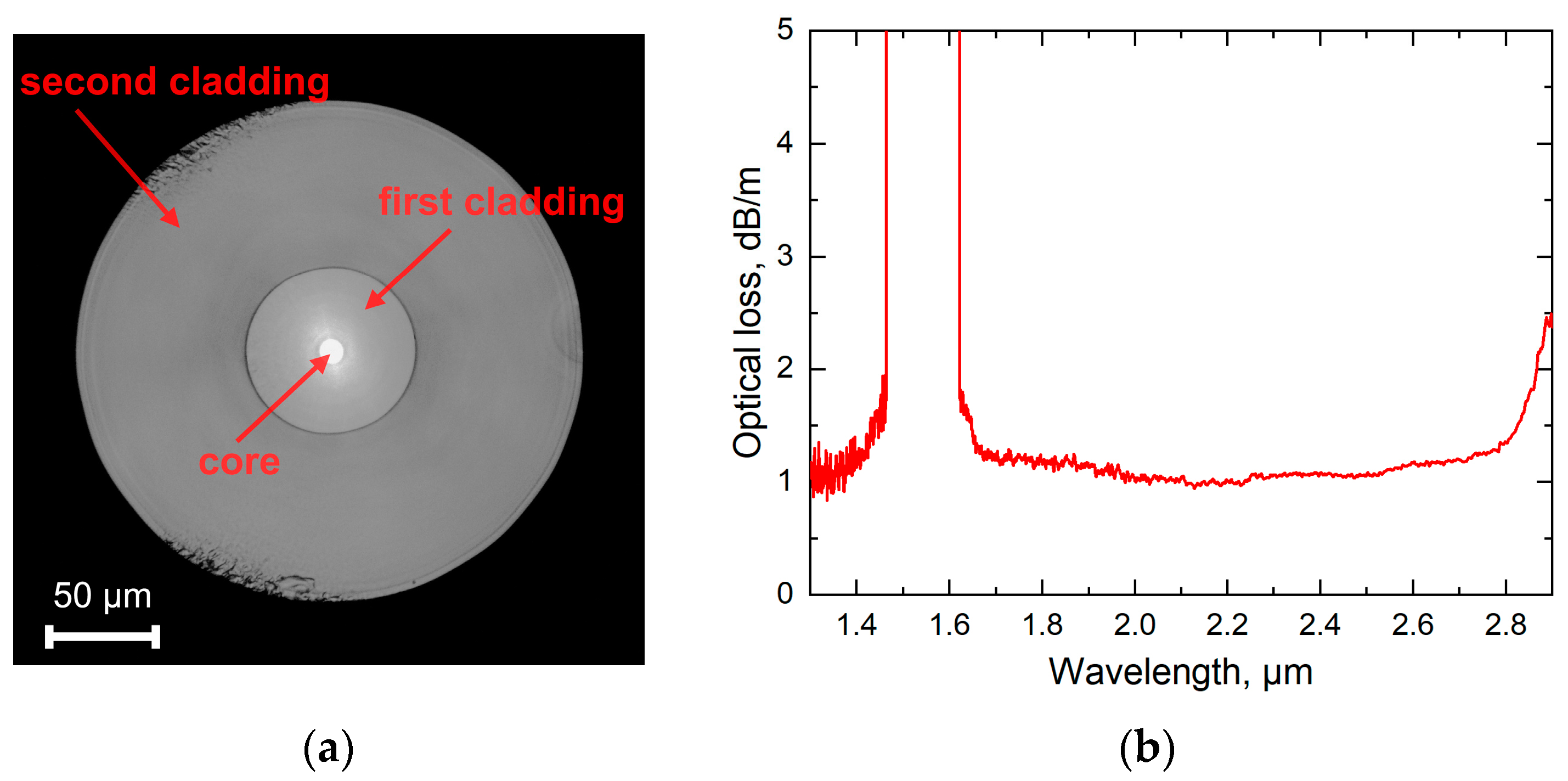
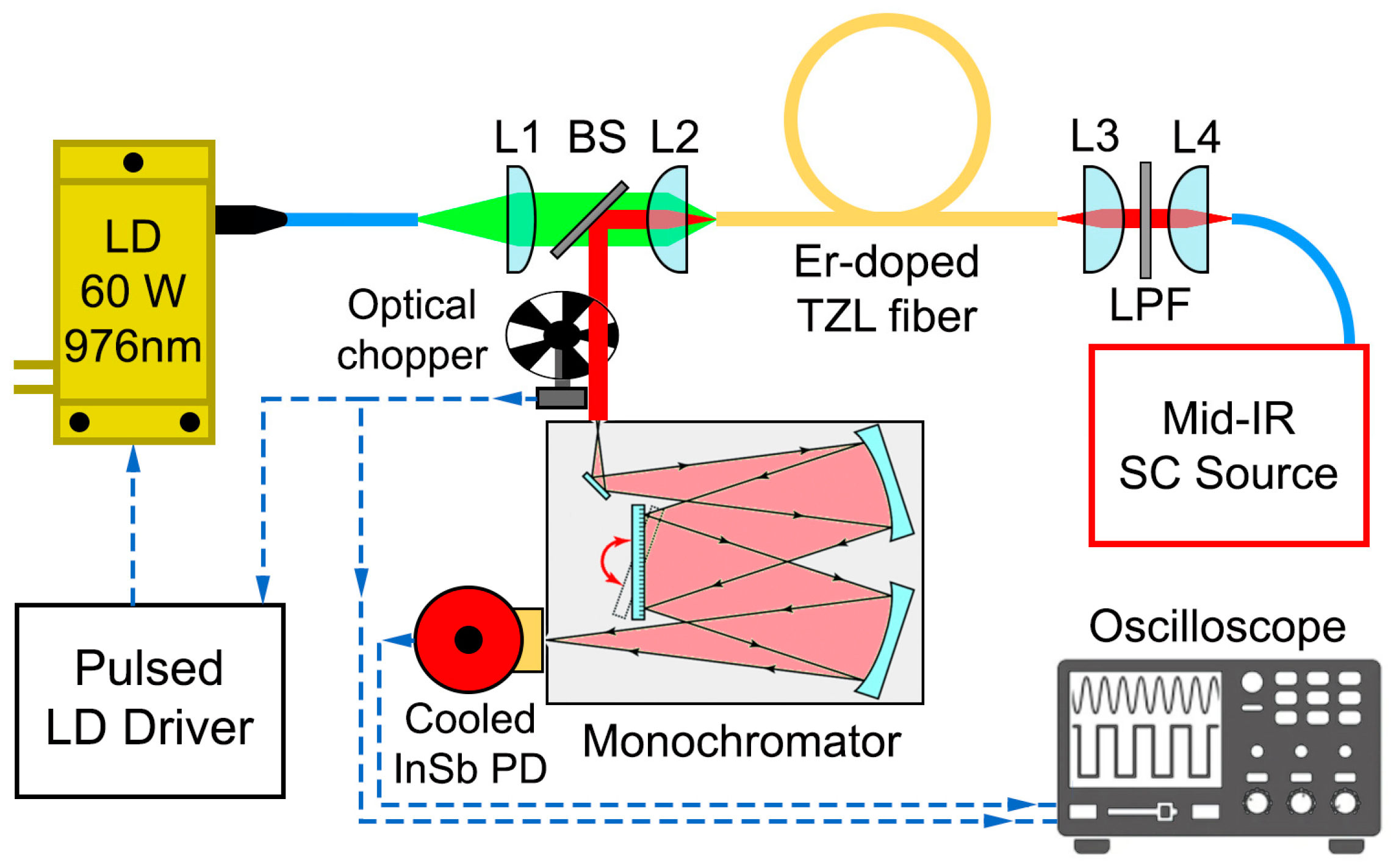
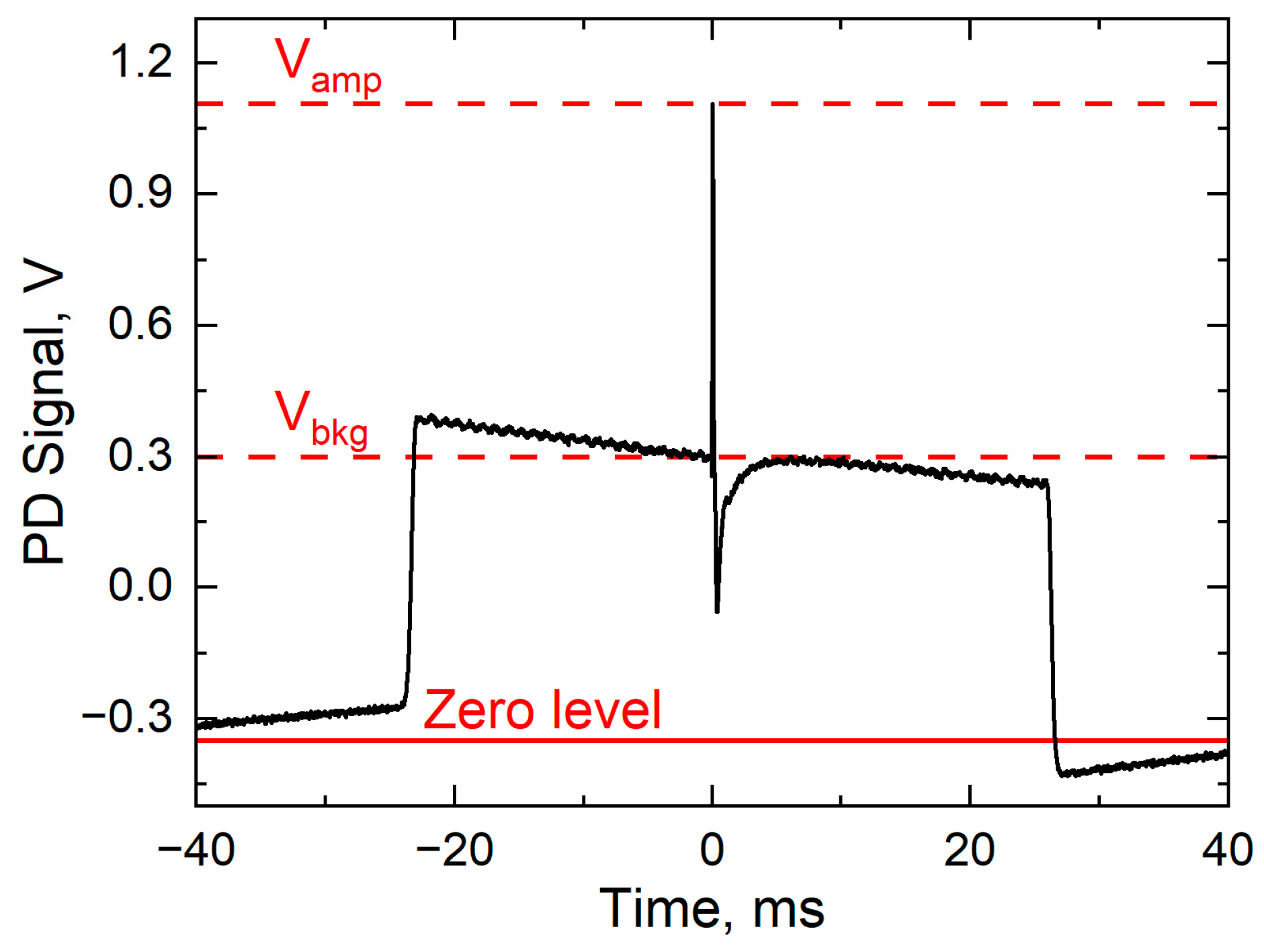
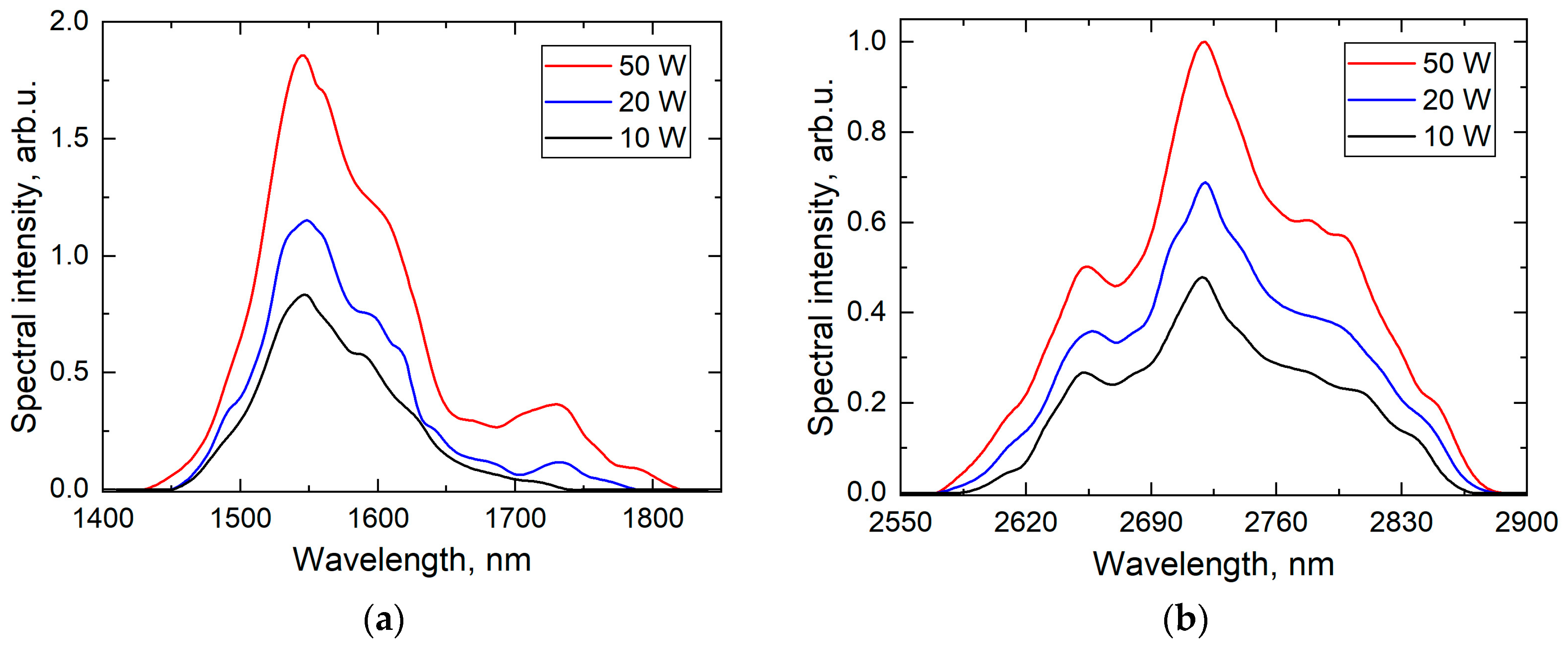
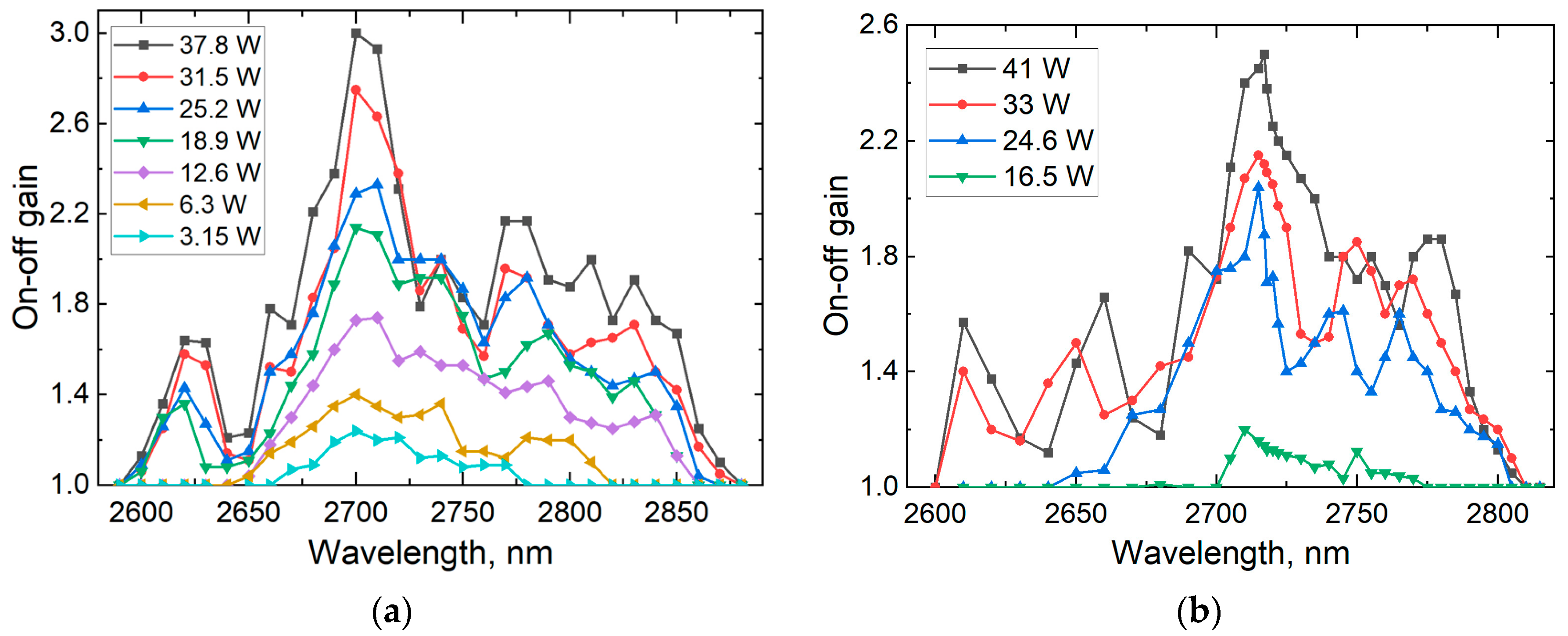
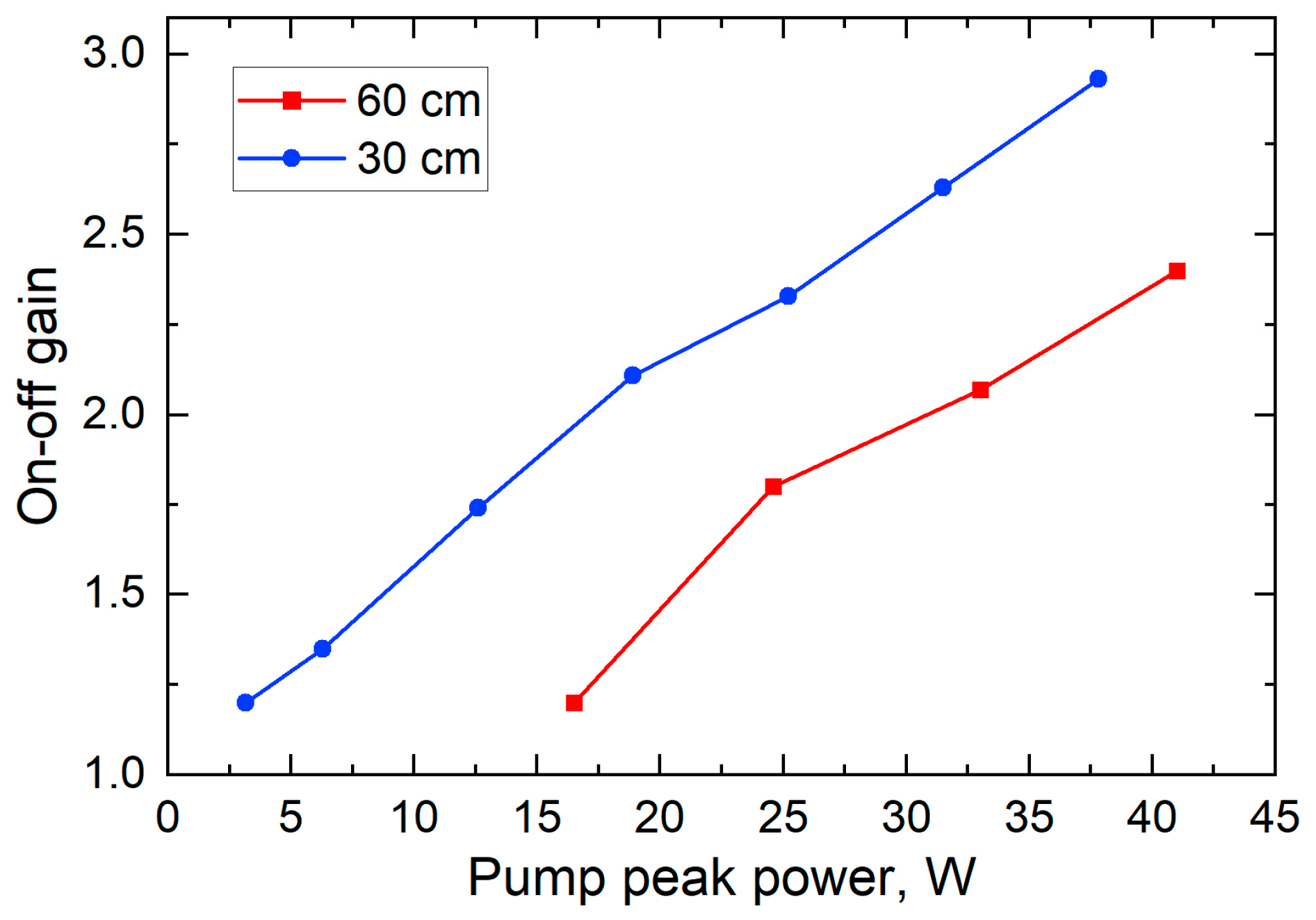
| Fiber Parameter | Value |
|---|---|
| Er2O3 concentration | 2.5 mol% |
| Core diameter | 10 µm |
| First cladding diameter | 71 µm |
| Second cladding diameter | 215 µm |
| Core NA | 0.18 |
| First cladding NA | 0.42 |
Disclaimer/Publisher’s Note: The statements, opinions and data contained in all publications are solely those of the individual author(s) and contributor(s) and not of MDPI and/or the editor(s). MDPI and/or the editor(s) disclaim responsibility for any injury to people or property resulting from any ideas, methods, instructions or products referred to in the content. |
© 2023 by the authors. Licensee MDPI, Basel, Switzerland. This article is an open access article distributed under the terms and conditions of the Creative Commons Attribution (CC BY) license (https://creativecommons.org/licenses/by/4.0/).
Share and Cite
Muraviev, S.; Dorofeev, V.; Kuznechikov, P.; Sharafeev, A.; Koptev, M.; Kim, A. Broadband Amplification in the 2.6–2.9 μm Wavelength Range in High-Purity Er3+-Doped Zinc-Tellurite Fibers Pumped by Diode Lasers. Photonics 2023, 10, 1140. https://doi.org/10.3390/photonics10101140
Muraviev S, Dorofeev V, Kuznechikov P, Sharafeev A, Koptev M, Kim A. Broadband Amplification in the 2.6–2.9 μm Wavelength Range in High-Purity Er3+-Doped Zinc-Tellurite Fibers Pumped by Diode Lasers. Photonics. 2023; 10(10):1140. https://doi.org/10.3390/photonics10101140
Chicago/Turabian StyleMuraviev, Sergei, Vitaly Dorofeev, Pavel Kuznechikov, Artem Sharafeev, Maksim Koptev, and Arkady Kim. 2023. "Broadband Amplification in the 2.6–2.9 μm Wavelength Range in High-Purity Er3+-Doped Zinc-Tellurite Fibers Pumped by Diode Lasers" Photonics 10, no. 10: 1140. https://doi.org/10.3390/photonics10101140





